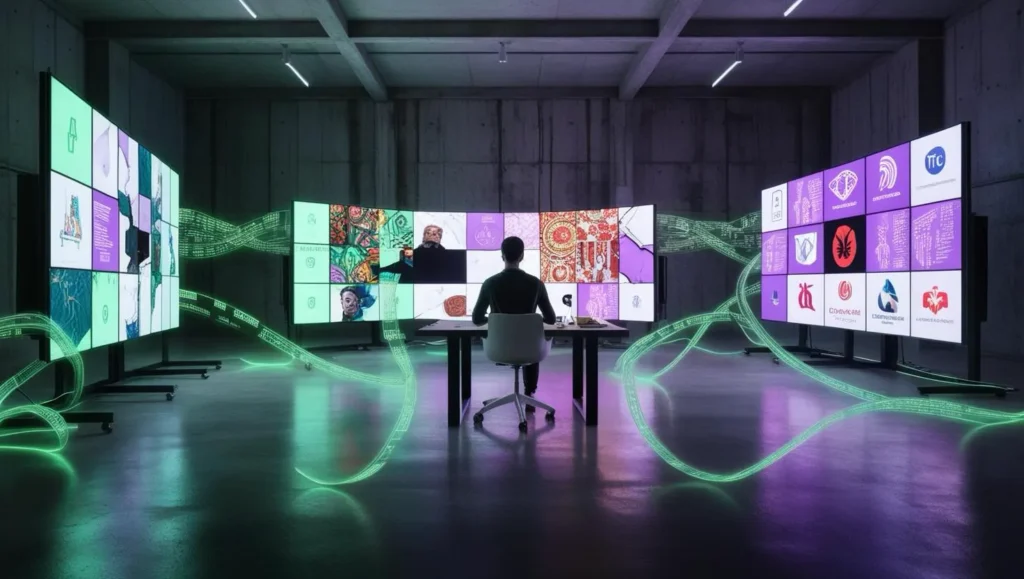Big Tech corporations exert significant control over artistic production in the digital environment. They dominate infrastructure, set standards, and exploit user data — all while portraying themselves as champions of innovation and creativity.
Control of Infrastructure and Platforms
Big Tech companies, often headquartered in the Global North, wield control over digital ecosystems, encompassing software, hardware, and network connectivity. This positions them as gatekeepers of the digital space and of the platforms where art is created and shared.
Take, for instance, the so-called GAFAM giants (Google, Apple, Facebook, Amazon, and Microsoft). While presenting their services as liberating tools for creators, these firms act as central nodes of information flow, monopolizing access to the contemporary digital world. Artists must rely on their platforms — be it social media, streaming services, or editing tools — to distribute their work.
Ironically, these corporations dictate the terms and conditions for using their platforms, ensuring that access is anything but equal. They control who gets data access, for what purpose, and under which commercial terms, reinforcing their dominance while subtly limiting creative freedom.
Standard-Setting and Algorithms
Another subtle form of control is through the establishment of standards. For example, Google dictates how websites should be designed for optimal indexing in its search engine. Ostensibly a technical guideline, this has far-reaching effects on the online visibility of artistic content.
Then come the almighty algorithms, the silent curators of our digital lives. These algorithms determine which content is promoted and which is buried under the digital rug. They directly impact which artists gain prominence and whose voices remain unheard.
Irony abounds: these decisions often prioritize Western cultural values, framing them as universal standards. As a result, the same systems that claim to connect the world instead reinforce cultural homogenization, sidelining diverse artistic practices.
Data Appropriation and the Attention Economy
Data is the currency of the digital age, and Big Tech knows it well. These corporations extract vast amounts of user data under the guise of improving personalization. They turn this information into economic value by analyzing user behavior and preferences.
Moreover, they control the attention habits of users, designing platforms to be addictive while capitalizing on the time users spend interacting with them. The data collected is then repurposed to predict — and, more troublingly, influence — human behavior.
This leads to a phenomenon dubbed “data colonialism”, where users are alienated from the very data they generate. While companies profit from surveillance, individuals are left with no real ownership or control over their digital footprints.
Impact on Cultural Diversity and Artistic Autonomy
The consequences of this control are far-reaching. Big Tech’s prioritization of Western cultural norms marginalizes non-Western narratives and practices. This erodes cultural diversity in the digital space, as voices from the Global South struggle to find visibility.
For local artists, access to global platforms is often restricted by technical and economic barriers imposed by Big Tech. Their creative autonomy is compromised by dependence on proprietary tools and platforms. These tools can change overnight — through updates, new policies, or pricing models — leaving artists at the mercy of corporate decisions.
Conclusion
The power of Big Tech corporations goes beyond infrastructure and platforms. They define standards, manipulate content visibility, and capitalize on user data, creating an environment where artistic production is both facilitated and constrained.
This scenario presents profound challenges for artists, especially those aiming to foster cultural diversity and achieve creative autonomy. However, the idea of “digital disruption” offers hope: by fostering collaboration among peripheral nations, it is possible to develop digital art practices aligned with local contexts. This approach seeks to decentralize technological control and create alternative spaces for artistic expression — spaces where creativity can truly thrive, free from the invisible hand of Big Tech.
Victor T. Murari
Art History, Education & Artificial Intelligence | PhD | Advancing Educational and Cultural Narratives through AI Integration

